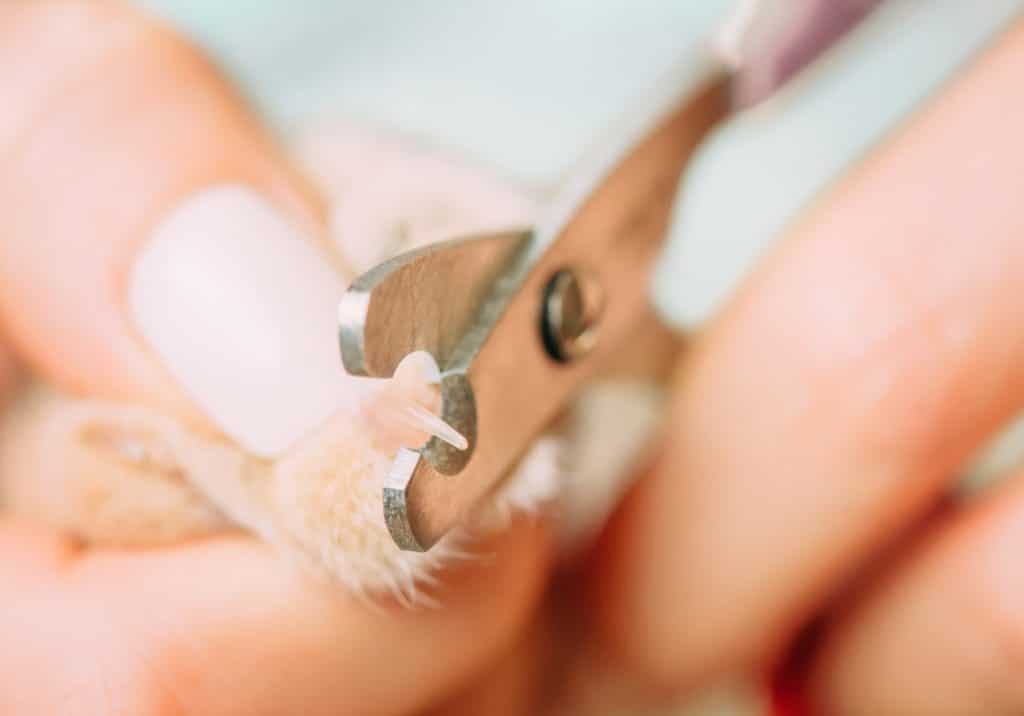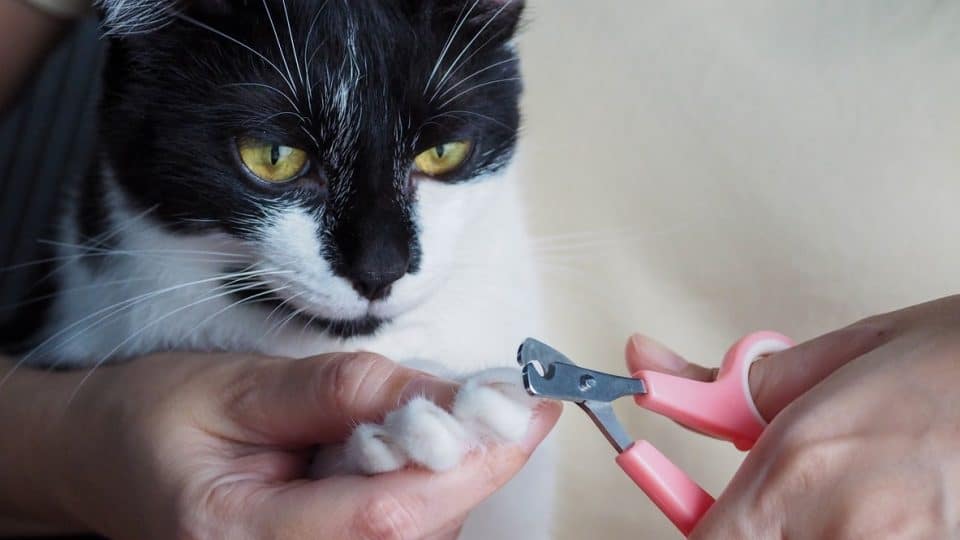- Not a substitute for professional veterinary help.
Cats love to scratch, so you might think you don’t need to trim their nails. But it’s important to do so. Cutting your cat’s nails every 2-4 weeks helps protect your furniture, prevents accidental scratches, and keeps your cat’s paws healthy.
“It benefits everyone to keep your cat’s claws clipped,” says Joey Lusvardi, Certified Cat Behavior Consultant and founder of Class Act Cats.
We’ve talked to cat experts, vets, and a groomer to bring you easy tips and advice on how to safely trim your cat’s nails and improve your grooming skills.
What Happens If You Don’t Trim Your Cat’s Nails?
A cat’s nails are very important, but if they get too long, it can be dangerous for the cat and everyone in the house. Cats’ nails keep growing, so they need regular trimming, whether they live indoors or outdoors.
While cats may bite their nails while grooming, it’s not enough to keep them short. You need a proper nail trimmer for that.
Dr. Dwight Alleyne, DVM, a Georgia-based small animal veterinarian with JustAnswer Veterinarian, says that if you don’t trim your cat’s nails, they can grow too long and start curling into their paw pads. This can cause pain, swelling, bleeding, infections, and even make walking hard for your cat.
Lastly, Amanda Caron, a cat behaviorist and founder of Frisky Feline Behavior Counseling, says cats in pain from long nails might scratch furniture, act out, or stop using the litter box, which can make them anxious.
When is It Time To Cut Your Cat’s Nails?
How often you trim your cat’s nails depends on their health and habits. Some cats might need a trim once a month, while older cats might need it every week because they have trouble retracting their nails or using scratching posts.
“On average, you will need to trim your cat’s claws every two to four weeks,” says Dr. Paola Cuevas Moreno, MVZ, senior veterinarian at Hepper.
Amanda Caron says it’s time to trim if your cat’s nails hinder their daily activities. This could mean their claws are getting stuck on couches, blankets, or rugs, or they are avoiding their scratching post. You might also notice them limping, moving less, or sticking their nails out even when resting.
Remember, overgrown or ingrown nails are different from a skin condition called hyperkeratosis, which looks like extra claws growing out of your cat’s paw pads.
How to Cut Your Cat’s Nails in 8 Steps
“Cats are all about choice. It’s important to let your cat set the stage for nail trims to make this a more cat-friendly experience,” Caron says.
Here are eight simple steps from Caron, Lusvardi, and Dr. Amber Carter, for cutting your cat’s nails at home:
1. Gather your supplies
Cat nail clippers aren’t a one-and-done purchase. Unlike duller human nail clippers, cat nail clippers should be sharper and more precise.
The three types of clippers for cat nails include:
- Electric grinders
- Guillotine-style clippers
- Scissor-style clippers
Dr. Carter and Lusvardi recommend scissors-style clippers. Their curved angle allows you to snip the tips of your cat’s claws without cutting into the sensitive quick. They’re also lightweight, easy to maneuver, clean, and maintain, and often come with built-in safety guards to help stop you from cutting your cat’s nails too short.
Other essential supplies include:
- Styptic power or gel (in case of bleeding)
- Ethanol
- Towels or a blanket
- Treats and toys
NOTE: Never use craft, kitchen scissors, or human nail clippers on your cat’s nails. Dr. Alleyne and Molly Bissantz, owner and groomer at Grooming by Molly, say cat nails are easy to break, crack, or split, so avoiding inappropriate tools like these is essential.
2. Prepare your cat
Every cat is different. There’s no one way to handle your cat when it’s time for their nail trim. Some cat parents and professionals swear by the kitty burrito technique.
Meanwhile, Caron suggests getting your cat used to you touching their paws and exposing them to the clippers beforehand. Once your cat is confident and calm, then you can begin clipping.
This method builds trust and shows kitties that having their paws handled isn’t bad or scary.
3. Create a quiet, calming space
Set up in a quiet, calm space before the nail trim begins. You can use theseg relaxation tools to help your kitty calm down:
- Diffusers
- Sprays
- Collars
- Thundershirts
- Calming treats
Other items you can bring include their favorite cat bed or cat tree.
4. Isolate the nail and identify the quick
Before cutting, identify the right spots to trim. You can gently press your cat’s toe beans to reveal the whole nail.
You might notice a thick, pinkish area inside your cat’s nails. This tissue is embedded in the nails and contains nerves and blood vessels.
Dr. Cuevas Moreno and Dr. Alleyne say clipping your cat’s nails too short might cut into their quick, causing heavy bleeding and excruciating pain.

iStock/Remains
5. Cut the nail at a 45-degree angle
Once the prep work is complete, it’s time to trim. Hold the clippers at a 45-degree angle and carefully snip just the tip of the nail. Repeat this for each nail.
This same trimming method applies whether you’re cutting your cat’s nails alone or with a partner.
6. Get help if needed
If you’re nervous about cutting your cat’s nails, don’t hesitate to ask for help. Bissantz and Lusvardi encourage cat parents who are uneasy about cutting their cat’s nails to seek outside help.
A veterinarian or trusted groomer who has years (or even decades!) of professional handling and clipping technique experience can give you a live tutorial. Or, if you’d rather they clip the nails, many vets and groomers often offer nail trims as part of their services.
7. Reward your cat
Depending on your cat’s preferences, Lusvardi and Caron say you can use many rewards to help your cat feel safe, secure, and happy during and after a nail trim.
After the trim, reward your cat with treats, playtime, or petting.
Takeaway
Cutting your cat’s nails safely takes patience and time. If your cat gets upset or nervous, stop, let them go, and try again later.
“You may initially only get one nail done or one foot done the first time, which is great,” Caron says. “It doesn’t need to all happen in a single session or even in the same week!”



